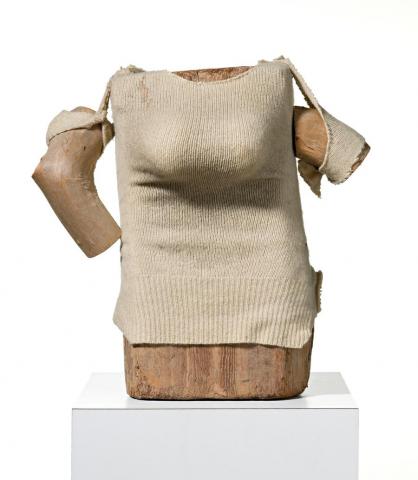MURRUMBIDGEE VENUS, c.1975
ROSALIE GASCOIGNE
weathered timber, wood, wool, nails and toy plastic balls
42.0 cm height
Acquired directly from the artist
Private collection, Melbourne
Deutscher and Hackett, Melbourne, 9 May 2007, lot 20
Private collection, Sydney
'...On Stromlo, there was a feeling of emptiness. Nothing happened: only jobs about the house and good deeds...Yet I have always had restless hands, and have had to do something, whether it was quilting, gardening, drying flowers, Ikebana, and have always had the help of a seeing eye. I know I can't draw but I can arrange...'1
With her training in the formal discipline of Ikebana complementing her intuitive understanding of the nature of materials, her deep attachment to her environment and later interest in modern art, Rosalie Gascoigne is regarded as one of Australia's most revered assemblage artists.
Bespeaking a staunchness and scrupulous eye, her assemblages such as the present are artful and refined, yet always maintain a close proximity to the outside world, powerfully evoking remembered feelings or memories in relationship to the landscape; '...they are instances of emotion recollected in tranquillity' to quote a phrase of Wordsworth's which was so dear to her. And indeed, therein lies one of the great paradoxes of her art - while she was a lover of the outdoors...by the same token her work displays all the formal qualities of the studio: as bricolage, as a formal discipline of aesthetic givens, it is entirely unprovincial.'2
Situated between the self-possession of still-life and the panoramic ambitions of landscape, Murrumbidgee Venus c.1975 encapsulates well the early phase of Gascoigne's achievement, her so-called 'object period' during which she would make assemblages of anything that took her fancy, as long as it was worn - glass pebbles, balls, car parts, toys, old inkwells. In the same vein as her wooden box sculptures featuring kewpie ('cupid') dolls produced around this time, so to the present work may be construed as a pun, parodying this mythological deity that so frequently populates Western Art. More profoundly perhaps, the work bears an unmistakable metaphorical resonance - like the materials themselves, beauty is a quality that is easily and thoughtlessly discarded. As John McDonald muses, 'When we value things for their perceived usefulness, we overlook a more fundamental necessity. Life is impoverished by the inability to recognise beauty in even the most humble guise.'3
1. Gascoigne, cited in Edwards, D., Rosalie Gascoigne: Materials as Landscape, Trustees of the Art Gallery of New South Wales, Sydney, 1998, p. 12
2. Wedde, I., How to be Nowhere: essays and texts 1971-1994, Victoria University Press, Wellington, 1995, p. 179
3. McDonald, J., 'Introduction' in MacDonald, V., Rosalie Gascoigne, Regaro, Sydney, 1998, p. 7
VERONICA ANGELATOS
